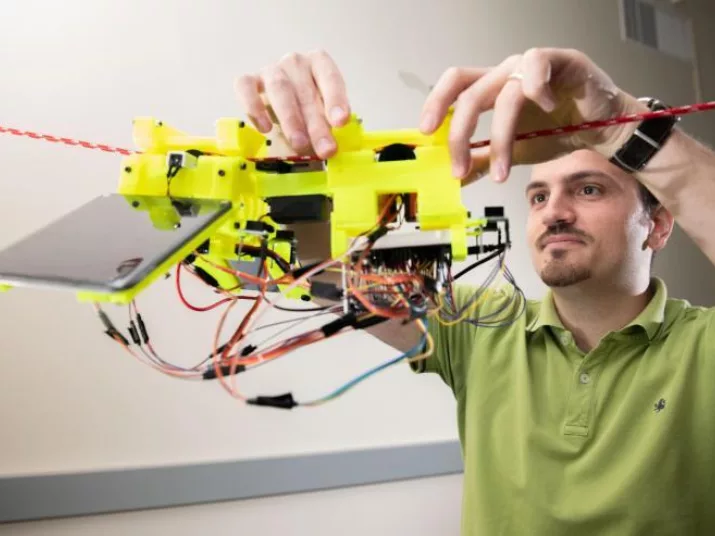
Photo: Allison Carter, Georgia Tech
The Modern Ways of Discovering New Species
The tools of biodiversity researchers
Long gone are the days when scientists roamed through nature, butterfly net and magnifying glass in hand, to capture the diversity of species. In the following, we’ll present a range of modern analytical methods that are used to detect new species or to record the distribution of known ones.

Photo: Allison Carter, Georgia Tech
We can only protect what we know – that’s the credo of biodiversity researchers. [1] However, recording the diversity and development of flora and fauna consumes a lot of time and resources. Which species live in which habitats? How large are their populations? How many individual organisms of a certain species live in a particular region? Answering these questions requires a range of methods – depending on the species, habitats or objectives under investigation.
In aquatic habitats, for example, researchers use trawl nets to determine the existing fish species, while divers count the number of sea dwellers in defined areas of the seabed. Ornithologists record birds with the aid of binoculars or through the traces they leave behind (such as feathers or nesting holes). Plants are identified, photographed and preserved in scientific collections. [2] Scientists distinguish between invasive methods, in which living beings are captured or even killed, and non-invasive methods such as acoustic recordings or observations with binoculars. Modern technologies support the recording of biodiversity. Here you can find several examples:
Example 1: Barcoding – hot on the trail of genetic material
Each species is distinguished by its specific “barcode”, that is, by a particular sequence of base pairs in the cellular DNA that is characteristic for the species. To gain information on animals, scientists often examine the DNA in the mitochondria (the power plants of the cells). With the help of special machines, this “genetic fingerprint” is read and compared to recordings in a gene database that already contains the genetic data of many species. [3] If the DNA of all living organisms found in a sample (for example in water or soil) is examined – instead of merely the genetic material of a single living organism – this is called meta-barcoding. [4] “More and more scientists across Germany have now taken to DNA barcoding,” says Regine Jahn, President of the German National Committee for the International Union of the Biological Sciences (IUBS) and the International Union of the Microbiological Societies (IUMS). After all, the method saves time and money; and even the tiniest parts of animals or plants are sufficient to identify the species – and no specialist is needed. [5]
Researchers also discuss the method’s contentious aspects as well as its advantages. For instance, geneticist Professor Dr Werner Kunz from Heinrich Heine University Düsseldorf writes: “A major advantage of barcode taxonomy [learn more about taxonomy here] is its time-saving, machine-driven mass-recording of species, which doesn’t require taxonomy specialists.” However, Professor Kunz points out that, especially in the case of species that are young from an evolutionary perspective (that is, species that developed relatively late in the course of the Earth’s history), considerable discrepancies occur between the classification of species according to the barcode concept and their classification according to reproductive communities or phenotypic characteristics. [6] In other words, genetic testing leads to a different classification of species than the one previously made that was, for example, based either on the shape of a plant or animal (phenotypic characteristics) or on the fact that individuals can reproduce with each other (reproductive communities). More information on the definition of “species” in biology is available here.
Example 2: Satellites, drones, robots – high-tech observers
With the help of cameras and sensors installed in drones or satellites, the gathering of information on the plant population in certain regions, for example, is made possible. By means of so-called hyperspectral imaging, researchers can measure the reflection of sunlight on surfaces – and thus recognise individual trees by their specific signature. [7] The technology even makes it possible to observe from space the migratory movements of animals. As part of the ICARUS project, scientists are equipping species such as birds, bats and flying foxes with miniature transmitters to facilitate the study of their movement patterns. According to the Helmholtz Centre for Environmental Research (UFZ), remote sensing is constantly gaining in importance for biodiversity research. “However, the choice of method must always take into account whether the remote sensing device is actually capable of measuring the selected key parameters. (...)” [8] Does the equipment provide recordings that are sufficiently detailed to address the research question being asked? How many images are taken, or recordings made, per day?
On Earth, for example, a small robot named SlothBot will be collecting data in natural surroundings in the future. It was developed by researchers at the Georgia Institute of Technology. Just like its role model from the animal world, the sloth, it doesn’t let itself get worked up about anything. It moves only to measure changes in its environment and therefore consumes very little energy. Along stretched metal ropes, it slowly makes its way through treetops and undergrowth. If the SlothBot needs fresh energy, it uses photovoltaic cells to recharge its batteries in the sun all by itself. In this way, it can get along on its own for weeks and months. The little robot is set to explore habitats like the jungle of Costa Rica. [9]
Example 3: Roaming nature per app – with the eyes of the crowd
An app and internet database enable voluntary environmentalists and amateur observers to keep an eye on the biodiversity in their surroundings – while supporting scientists in their research. They use their smartphones to take photos of animals or plants, which are then evaluated by software. On platforms such as www.buergerschaffenwissen.de, nature enthusiasts can find themselves projects to participate in. Apps to join in are listed here.
[1] https://www.researchgate.net/publication/299536708_Biodiversitat_erfassen_von_Suppen_und_Satelliten
[2] https://www.klima-warnsignale.uni-hamburg.de/wp-content/uploads/2017/01/gutt_auliya.pdf
[3] https://www.researchgate.net/publication/299536708_Biodiversitat_erfassen_von_Suppen_und_Satelliten
[4] https://www.researchgate.net/publication/299536708_Biodiversitat_erfassen_von_Suppen_und_Satelliten
[5] https://www.welt.de/regionales/bayern/article164276624/Forscher-bieten-DNA-Barcoding-fuer-jedermann.html
[6] https://onlinelibrary.wiley.com/doi/full/10.1002/biuz.201810647
[7] http://www.enmap.org/sites/default/files/pdf/pub/EnMAP_Internet_l_Magazin.pdf
[8] https://www.ufz.de/index.php?de=36336&webc_pm=51/2016
[9] https://www.news.gatech.edu/2019/05/30/slothbot-takes-leisurely-approach-environmental-monitoring